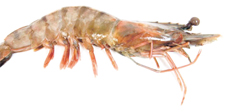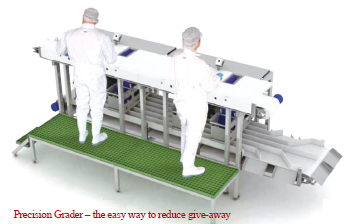
BLACK tiger shrimp are the single most widely distributed and marketed shrimp in the world. Asian producers of black tiger shrimp are starting to see the huge potential for increased profit and improved grading quality by changing from manual to automatic grading. Grading of black tiger shrimp is today primarily done manually by hand picking one shrimp at a time and basing the size and grade on visual inspection. Once in a while the packer checks the weight of the shrimp on a bench scale. This kind of packing operation has a very low capacity and is inaccurate. By installing an automatic grader, producers are certain to obtain better grading results and higher quality.
Exporting to Japan Japan is the biggest market for black tiger shrimp and strict rules apply with regard to grades and sizes. If importers detect shrimps in a shipment that do not comply with the grading specifications, they may return the entire shipment to the producer, who would thus incur considerable extra costs. Many Asian producers therefore compensate by underestimating the size instead of taking the risk of overestimating, in order to be sure to comply with the size specifications for Japan. Automatic grading, which is extremely accurate, practically eliminates this problem.
 Payback time of less than a year
Payback time of less than a year Even small improvements in grading accuracy in the large product/high price category, can lead to a payback time of less than a year. In addition, processors will no longer have to contend with finding and keeping well-trained people for this operation, which is becoming increasingly difficult. For grading jobs, Marel offers a static shrimp grader with +/- 0.2 g accuracy for 85% of the weighings. With the Precision Grader, which has 10 scales/work stations, it is possible to grade up to 750 shrimps per minute into predetermined weight categories. Marel's fixed-weight batching solution, the Target Batcher, reduces give-away with seven high-accuracy individual scales and 14 holding bins. The system selects the best combination of a defined number of shrimps in a fraction of a second, or a capacity of 20-30 batches per minute, depending on the number of pieces in the batch and the infeed speed.(the end)
Nike Air Max 270 BLACK tiger shrimp are the single most widely distributed and marketed shrimp in the world. Asian producers of black tiger shrimp are starting to see the huge potential for increased profit and improved grading quality by changing from manual to automatic grading. Grading of black tiger shrimp is today primarily done manually by hand picking one shrimp at a time and basing the size and grade on visual inspection. Once in a while the packer checks the weight of the shrimp on a bench scale. This kind of packing operation has a very low capacity and is inaccurate. By installing an automatic grader, producers are certain to obtain better grading results and higher quality. Exporting to Japan Japan is the biggest market for black tiger shrimp and strict rules apply with regard to grades and sizes. If importers detect shrimps in a shipment that do not comply with the grading specifications, they may return the entire shipment to the producer, who would thus incur considerable extra costs. Many Asian producers therefore compensate by underestimating the size instead of taking the risk of overestimating, in order to be sure to comply with the size specifications for Japan. Automatic grading, which is extremely accurate, practically eliminates this problem.
BLACK tiger shrimp are the single most widely distributed and marketed shrimp in the world. Asian producers of black tiger shrimp are starting to see the huge potential for increased profit and improved grading quality by changing from manual to automatic grading. Grading of black tiger shrimp is today primarily done manually by hand picking one shrimp at a time and basing the size and grade on visual inspection. Once in a while the packer checks the weight of the shrimp on a bench scale. This kind of packing operation has a very low capacity and is inaccurate. By installing an automatic grader, producers are certain to obtain better grading results and higher quality. Exporting to Japan Japan is the biggest market for black tiger shrimp and strict rules apply with regard to grades and sizes. If importers detect shrimps in a shipment that do not comply with the grading specifications, they may return the entire shipment to the producer, who would thus incur considerable extra costs. Many Asian producers therefore compensate by underestimating the size instead of taking the risk of overestimating, in order to be sure to comply with the size specifications for Japan. Automatic grading, which is extremely accurate, practically eliminates this problem.  Payback time of less than a year Even small improvements in grading accuracy in the large product/high price category, can lead to a payback time of less than a year. In addition, processors will no longer have to contend with finding and keeping well-trained people for this operation, which is becoming increasingly difficult. For grading jobs, Marel offers a static shrimp grader with +/- 0.2 g accuracy for 85% of the weighings. With the Precision Grader, which has 10 scales/work stations, it is possible to grade up to 750 shrimps per minute into predetermined weight categories. Marel's fixed-weight batching solution, the Target Batcher, reduces give-away with seven high-accuracy individual scales and 14 holding bins. The system selects the best combination of a defined number of shrimps in a fraction of a second, or a capacity of 20-30 batches per minute, depending on the number of pieces in the batch and the infeed speed.(the end)Nike Air Max 270
Payback time of less than a year Even small improvements in grading accuracy in the large product/high price category, can lead to a payback time of less than a year. In addition, processors will no longer have to contend with finding and keeping well-trained people for this operation, which is becoming increasingly difficult. For grading jobs, Marel offers a static shrimp grader with +/- 0.2 g accuracy for 85% of the weighings. With the Precision Grader, which has 10 scales/work stations, it is possible to grade up to 750 shrimps per minute into predetermined weight categories. Marel's fixed-weight batching solution, the Target Batcher, reduces give-away with seven high-accuracy individual scales and 14 holding bins. The system selects the best combination of a defined number of shrimps in a fraction of a second, or a capacity of 20-30 batches per minute, depending on the number of pieces in the batch and the infeed speed.(the end)Nike Air Max 270
 iConnectHub
iConnectHub
 Login/Register
Login/Register Supplier Login
Supplier Login


























